steering Citroen C3 PICASSO RHD 2015 1.G User Guide
[x] Cancel search | Manufacturer: CITROEN, Model Year: 2015, Model line: C3 PICASSO RHD, Model: Citroen C3 PICASSO RHD 2015 1.GPages: 292, PDF Size: 8.16 MB
Page 123 of 292
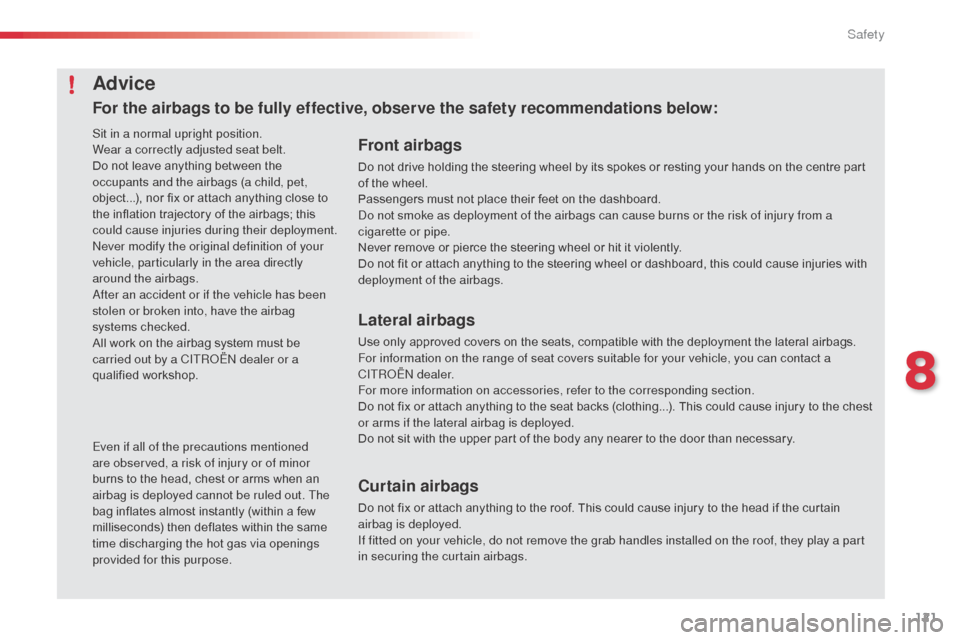
121
Front airbags
Do not drive holding the steering wheel by its spokes or resting your hands on the centre part
of the wheel.
Passengers must not place their feet on the dashboard.
Do not smoke as deployment of the airbags can cause burns or the risk of injury from a
cigarette or pipe.
Never remove or pierce the steering wheel or hit it violently.
Do not fit or attach anything to the steering wheel or dashboard, this could cause injuries with
deployment of the airbags.
Lateral airbags
Use only approved covers on the seats, compatible with the deployment the lateral airbags.
For information on the range of seat covers suitable for your vehicle, you can contact a
CITROËN
dealer.
For more information on accessories, refer to the corresponding section.
Do not fix or attach anything to the seat backs (clothing...). This could cause injury to the chest
or arms if the lateral airbag is deployed.
Do not sit with the upper part of the body any nearer to the door than necessary.
Curtain airbags
Do not fix or attach anything to the roof. This could cause injury to the head if the curtain
airbag is deployed.
If fitted on your vehicle, do not remove the grab handles installed on the roof, they play a part
in securing the curtain airbags.
For the airbags to be fully effective, observe the safety recommendations below:
Even if all of the precautions mentioned
are observed, a risk of injury or of minor
burns to the head, chest or arms when an
airbag is deployed cannot be ruled out. The
bag inflates almost instantly (within a few
milliseconds) then deflates within the same
time discharging the hot gas via openings
provided for this purpose.
Advice
Sit in a normal upright position.
Wear a correctly adjusted seat belt.
Do not leave anything between the
occupants and the airbags (a child, pet,
object...), nor fix or attach anything close to
the inflation trajectory of the airbags; this
could cause injuries during their deployment.
Never modify the original definition of your
vehicle, particularly in the area directly
around the airbags.
After an accident or if the vehicle has been
stolen or broken into, have the airbag
systems checked.
All work on the airbag system must be
carried out by a CITROËN dealer or a
qualified workshop.
8
Safety
Page 125 of 292
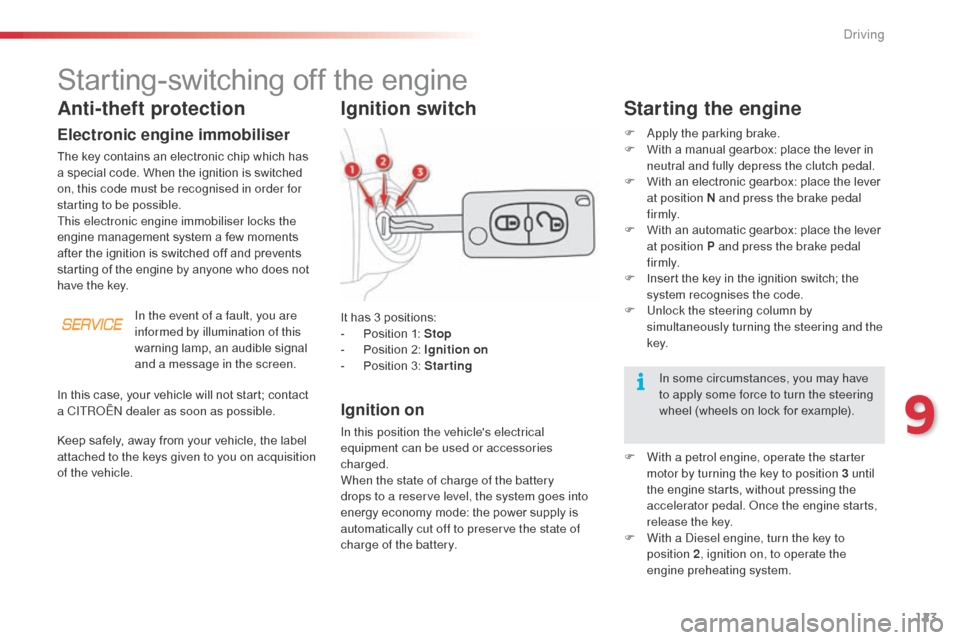
123
Electronic engine immobiliser
The key contains an electronic chip which has
a special code. When the ignition is switched
on, this code must be recognised in order for
starting to be possible.
This electronic engine immobiliser locks the
engine management system a few moments
after the ignition is switched off and prevents
starting of the engine by anyone who does not
have the key.
Anti-theft protection
In the event of a fault, you are
informed by illumination of this
warning lamp, an audible signal
and a message in the screen.
Ignition switch
It has 3 positions:
- P osition 1: Stop
-
P
osition 2: Ignition on
-
P
osition 3: Starting
Ignition on
In this position the vehicle's electrical
equipment can be used or accessories
charged.
When the state of charge of the battery
drops to a reserve level, the system goes into
energy economy mode: the power supply is
automatically cut off to preserve the state of
charge of the battery.
Keep safely, away from your vehicle, the label
attached to the keys given to you on acquisition
of the vehicle. In this case, your vehicle will not start; contact
a CITROËN dealer as soon as possible.
Starting-switching off the engine
Starting the engine
F Apply the parking brake.
F
W ith a manual gearbox: place the lever in
neutral and fully depress the clutch pedal.
F
W
ith an electronic gearbox: place the lever
at position N and press the brake pedal
f i r m l y.
F
W
ith an automatic gearbox: place the lever
at position P and press the brake pedal
f i r m l y.
F
I
nsert the key in the ignition switch; the
system recognises the code.
F
U
nlock the steering column by
simultaneously turning the steering and the
key.
F
W
ith a petrol engine, operate the starter
motor by turning the key to position 3 until
the engine starts, without pressing the
accelerator pedal. Once the engine starts,
release the key.
F
W
ith a Diesel engine, turn the key to
position 2 , ignition on, to operate the
engine preheating system. In some circumstances, you may have
to apply some force to turn the steering
wheel (wheels on lock for example).
9
Driving
Page 126 of 292
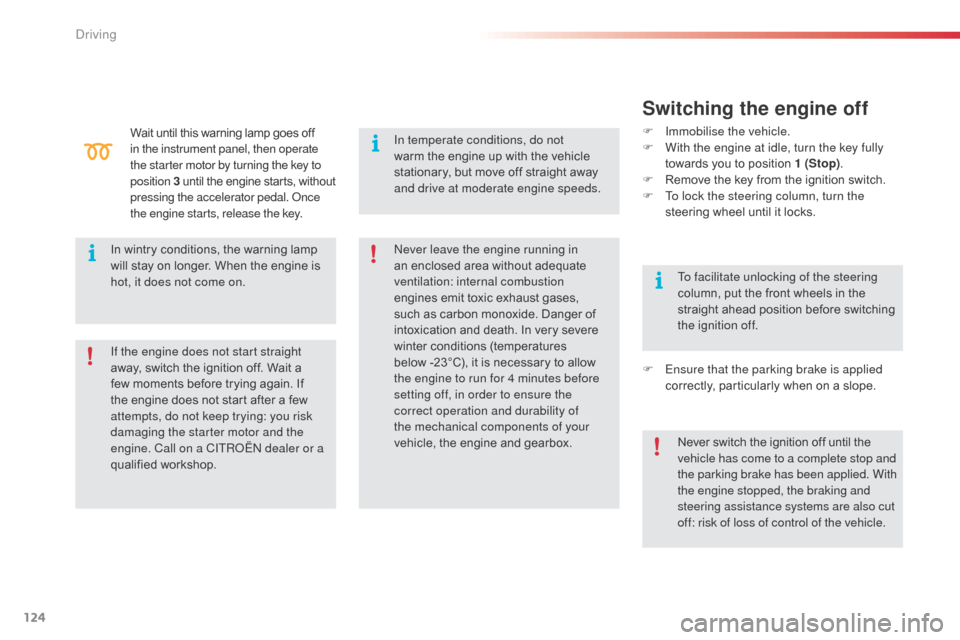
124
Never leave the engine running in
an enclosed area without adequate
ventilation: internal combustion
engines emit toxic exhaust gases,
such as carbon monoxide. Danger of
intoxication and death. In very severe
winter conditions (temperatures
below -23°C), it is necessary to allow
the engine to run for 4 minutes before
setting off, in order to ensure the
correct operation and durability of
the mechanical components of your
vehicle, the engine and gearbox.
If the engine does not start straight
away, switch the ignition off. Wait a
few moments before trying again. If
the engine does not start after a few
attempts, do not keep trying: you risk
damaging the starter motor and the
engine. Call on a CITROËN dealer or a
qualified workshop. In temperate conditions, do not
warm the engine up with the vehicle
stationary, but move off straight away
and drive at moderate engine speeds.
In wintry conditions, the warning lamp
will stay on longer. When the engine is
hot, it does not come on. Wait until this warning lamp goes off
in the instrument panel, then operate
the starter motor by turning the key to
position
3 until the engine starts, without
pressing the accelerator pedal. Once
the engine starts, release the key.
Switching the engine off
F Immobilise the vehicle.
F W ith the engine at idle, turn the key fully
towards you to position 1 (Stop) .
F
R
emove the key from the ignition switch.
F
T
o lock the steering column, turn the
steering wheel until it locks.
Never switch the ignition off until the
vehicle has come to a complete stop and
the parking brake has been applied. With
the engine stopped, the braking and
steering assistance systems are also cut
off: risk of loss of control of the vehicle. To facilitate unlocking of the steering
column, put the front wheels in the
straight ahead position before switching
the ignition off.
F
E
nsure that the parking brake is applied
correctly, particularly when on a slope.
Driving
Page 128 of 292
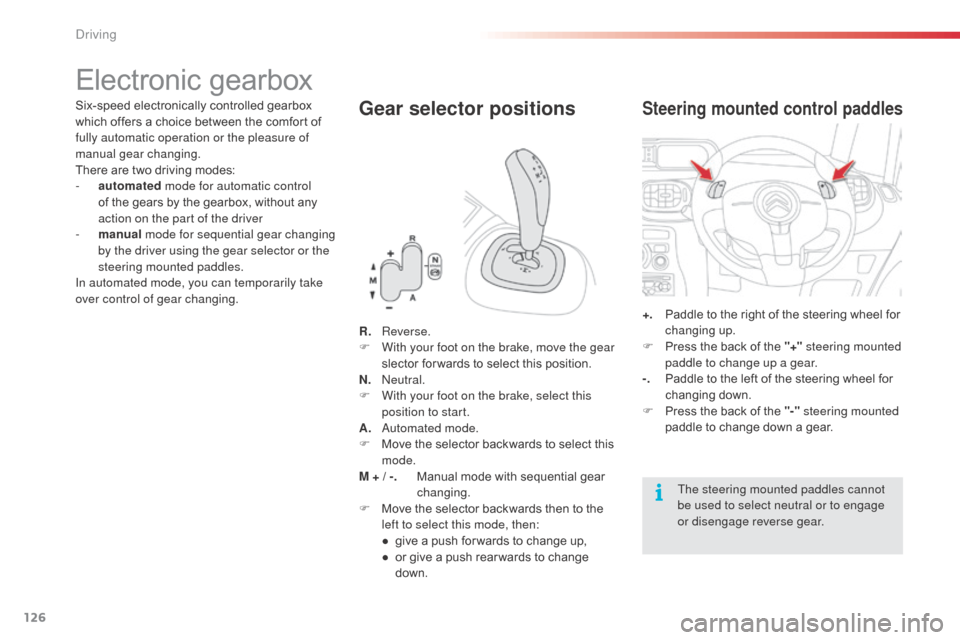
126
Electronic gearbox
Six-speed electronically controlled gearbox
which offers a choice between the comfort of
fully automatic operation or the pleasure of
manual gear changing.
There are two driving modes:
-
a
utomated mode for automatic control
of the gears by the gearbox, without any
action on the part of the driver
-
m
anual mode for sequential gear changing
by the driver using the gear selector or the
steering mounted paddles.
In automated mode, you can temporarily take
over control of gear changing.Gear selector positions
R. Reverse.
F W ith your foot on the brake, move the gear
slector for wards to select this position.
N.
N
eutral.
F
W
ith your foot on the brake, select this
position to start.
A.
A
utomated mode.
F
M
ove the selector backwards to select this
mode.
M + / -.
M
anual mode with sequential gear
changing.
F
M
ove the selector backwards then to the
left to select this mode, then:
●
g
ive a push for wards to change up,
●
o
r give a push rear wards to change
down. +.
P
addle to the right of the steering wheel for
changing up.
F P ress the back of the "+" steering mounted
paddle to change up a gear.
-.
P
addle to the left of the steering wheel for
changing down.
F
P
ress the back of the "-" steering mounted
paddle to change down a gear.
Steering mounted control paddles
The steering mounted paddles cannot
be used to select neutral or to engage
or disengage reverse gear.
Driving
Page 130 of 292

128
F Select position M. To engage reverse gear R
, the vehicle must be
immobilised with your foot on the brake pedal.
F
Sel
ect position R.
At very low speed, if reverse gear is requested,
this will only be acted on when the vehicle is
immobilised.
At high speed, if reverse gear is requested,
the
N indicator flashes and the gearbox goes
into neutral. To engage a gear again, put the
gear selector into position A or M .Temporary control of gear
changing
You can temporarily take over control of
gear changing using the "+" and "-" steering
mounted paddles: if the engine speed allows,
the request to change gear is acted on.
This function allows you to anticipate certain
situations such as overtaking a vehicle or the
approach to a corner.
After a few moments without any action on
the control paddles, the gearbox resumes
automatic control of the gears. The gears engaged appear in
succession in the instrument panel
screen.
The gear change requests are only acted on if
the engine speed permits.
It is not necessary to release the accelerator
during gear changes.
When braking or slowing down, the gearbox
changes down automatically to allow the
vehicle to accelerate in the correct gear.
On sharp acceleration, the gearbox will not
change up unless the driver acts on the gear
selector or the steering mounted paddles.
Never select neutral N while the vehicle
is moving. You can change mode at any time, be
moving the gear selecto from M to A or
the other way round. Engagement of reverse gear is
accompanied by an audible signal.
Manual mode
Reverse
Driving
Page 134 of 292
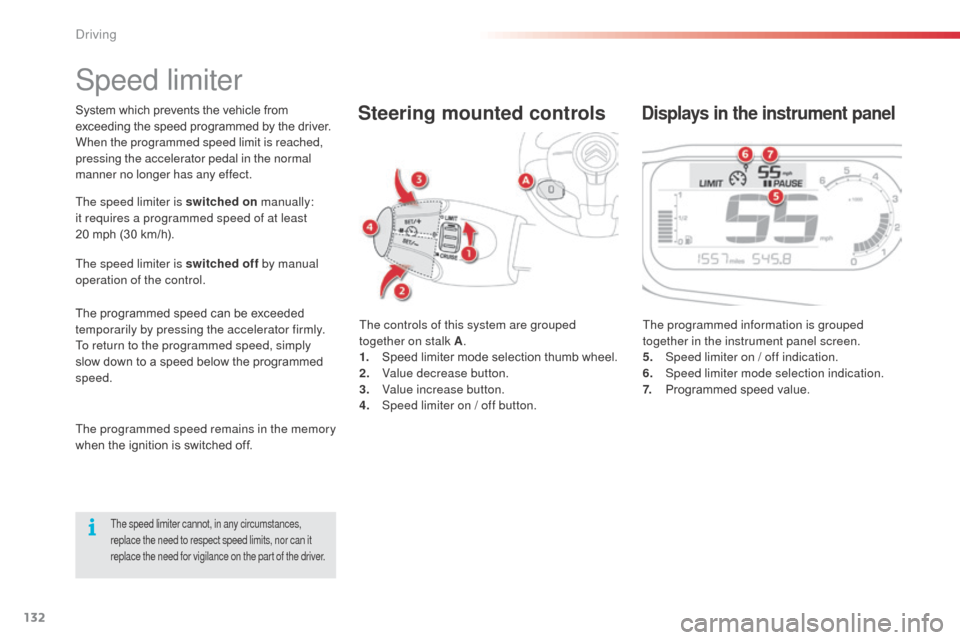
132
Speed limiter
The controls of this system are grouped
together on stalk A.
1.
S
peed limiter mode selection thumb wheel.
2.
V
alue decrease button.
3.
V
alue increase button.
4.
S
peed limiter on / off button. The programmed information is grouped
together in the instrument panel screen.
5.
S
peed limiter on / off indication.
6.
Spe
ed limiter mode selection indication.
7.
P
rogrammed speed value.
Steering mounted controlsDisplays in the instrument panel
The speed limiter is switched on manually:
it requires a programmed speed of at least
20
mph (30 km/h).
The speed limiter is switched off by manual
operation of the control.
The programmed speed can be exceeded
temporarily by pressing the accelerator firmly.
To return to the programmed speed, simply
slow down to a speed below the programmed
speed.
The programmed speed remains in the memory
when the ignition is switched off.
The speed limiter cannot, in any circumstances,
replace the need to respect speed limits, nor can it
replace the need for vigilance on the part of the driver.
System which prevents the vehicle from
exceeding the speed programmed by the driver.
When the programmed speed limit is reached,
pressing the accelerator pedal in the normal
manner no longer has any effect.
Driving
Page 136 of 292

134
System which automatically maintains the
speed of the vehicle at the value programmed
by the driver, without any action on the
accelerator pedal.The controls of this system are grouped
together on control stalk A.The programmed information is grouped
together in the instrument panel screen.Steering mounted controlsDisplays in the instrument panel
The cruise control is switched on
manually: it
requires a minimum vehicle speed of 25 mph
(40 km/h) and 4th gear or higher engaged.
The cruise control is switched off manually
or by pressing the brake or clutch pedal or
on triggering of the ESP system for safety
reasons.
It is possible to exceed the programmed speed
temporarily by pressing the accelerator pedal.
To return to the programmed speed, simply
release the accelerator pedal.
Switching off the ignition cancels any
programmed speed value. 1.
C
ruise control mode selection thumb whee;
2.
S
peed programming / value decrease
button
3.
S
peed programming / value increase
button
4.
C
ruise control off / resume button5.
C
ruise control off / resume indication
6.
C
ruise control mode selection indication
7.
P
rogrammed speed value
The cruise control cannot, in any circumstances,
replace the need to respect speed limits, nor can it
replace the need for vigilance on the part of the driver.
Cruise control
Driving
Page 180 of 292

178
Dashboard fuses
The fusebox is located in the glove box.
Access to the fuses
F refer to the paragraph "Access to the tooling".
Fuse tables
Fuse N° Rating Functions
FH36 5 ATrailer relay unit.
FH37 15 ATrailer accessories socket supply.
FH38 20 ANavigation.
FH39 -Not used.
FH40 30 ATrailer relay unit.
Fuse N° Rating Functions
F1 15 ARear wiper.
F2 -Not used.
F3 5 AAirbags and pretensioners control unit.
F4 10 ASteering wheel angle sensor, air conditioning, clutch switch,
particle filter pump, diagnostic socket, air flow meter.
F5 30 AElectric windows panel, passenger's electric window control,
front electric windows motor.
F6 30 ARear electric windows motor and driver's electric window motor.
F7 5 ACourtesy and front map reading lamps, rear reading lamps.
Practical information
Page 181 of 292
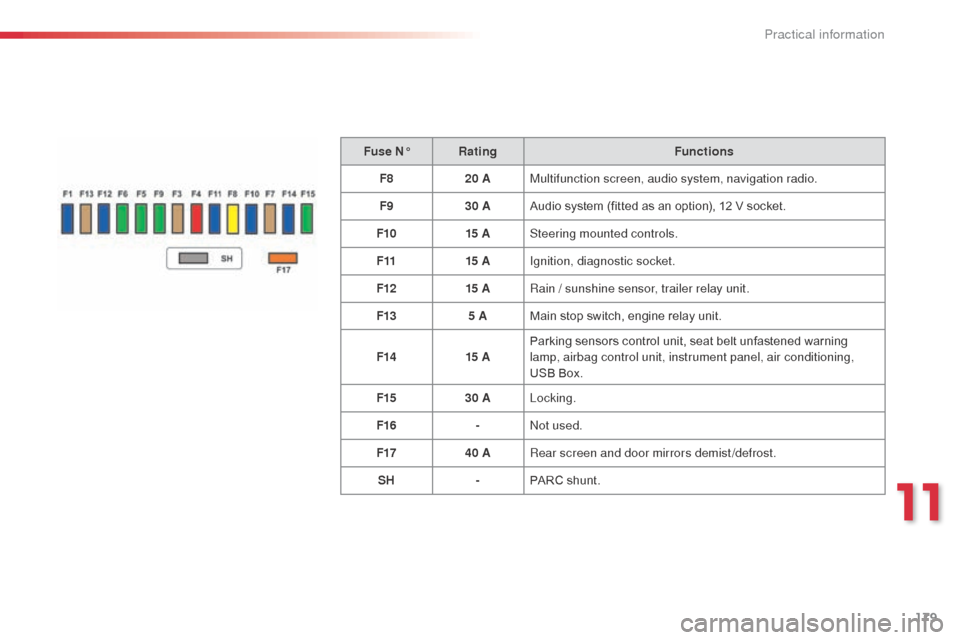
179
Fuse N°Rating Functions
F8 20 AMultifunction screen, audio system, navigation radio.
F9 30 AAudio system (fitted as an option), 12 V socket.
F10 15 ASteering mounted controls.
F11 15 AIgnition, diagnostic socket.
F12 15 ARain / sunshine sensor, trailer relay unit.
F13 5 AMain stop switch, engine relay unit.
F14 15 AParking sensors control unit, seat belt unfastened warning
lamp, airbag control unit, instrument panel, air conditioning,
USB Box.
F15 30 ALocking.
F16 -Not used.
F17 40 ARear screen and door mirrors demist/defrost.
SH -PARC shunt.
11
Practical information
Page 183 of 292

181
Fuse N°Rating Functions
F1 20 AEngine control unit supply, cooling fan unit control, multifunction
engine control main relay.
F2 15 AHorn.
F3 10 AFront / rear wash-wipe.
F4 20 ADaytime running lamps.
F5 15 ADiesel fuel heater (Diesel engine), fuel pump (petrol engine)
F6 10 AABS/ESP control unit, ABS/ESP cut-off relay, secondary stop
switch.
F7 10 AElectrical power steering.
F8 25 AStarter control.
F9 10 ASwitching and protection unit (Diesel).
F10 30 ADiesel engine injection pump valve, injectors and ignition coils
(petrol engine)
F11 40 AAir conditioning fan.
Fuse table
11
Practical information